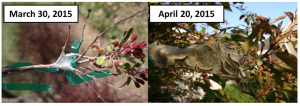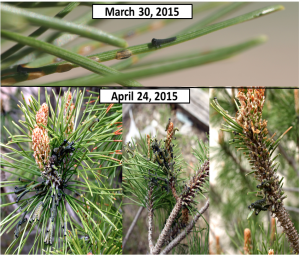—by Dr. Bob Bauernfeind
While recent cool temperatures have had people wondering when warmer temperatures will prevail, both ETC and EPS have thrived —– not surprising because these are cool-season insects.
Currently, Eastern Tent Caterpillar “tents” are of sufficient size that they can be easily detected. If people object to the presence of webbing and caterpillars, and if within hands-reach, the easiest remedy is to use your fingers to “rake-out” the web. Preferably do this during daylight hours when most (if not all) caterpillars are “resting” within. Do not fret if several caterpillars fall to the ground —- individually, the few escapees are of no concern. If a person is skittish about touching web masses (and the caterpillars and frass within), that portion of the branch can be pruned and disposed of.
European pine sawflies require a different approach because it is impractical to prune out each infested terminal. Fortunately, EPS are highly susceptible to insecticides. There are numerous products registered for use in Kansas against EPS. Horticultural oils and soaps are very effective against the “soft-bodied” larvae. A single thorough application will eliminate EPS larvae. But do so NOW before they become thoroughly destructive.

